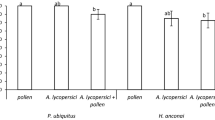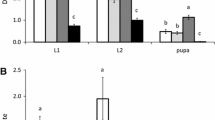Abstract
Overwintering and diapause are variable among mite species and strains. The aims of this study were to determine whether certain crops constitute overwintering sites for the Argentine strain of the predator Neoseiulus californicus and whether females underwent reproductive diapause in winter. Neoseiulus californicus was recorded monthly on the vegetables tomato, sweet pepper, eggplant, and artichoke, and on strawberry, among other crops in Buenos Aires province, Argentina. This mite was found at a lower percentage of crops in the winter than in the other seasons. Since the predator was quite frequent on artichoke, this crop could constitute a refuge during adverse environmental conditions. The mite’s frequency on several crops in other seasons and potential association with a strawberry pest is discussed. In the laboratory, individuals exposed to winter conditions throughout the life cycle exhibited a long pre-oviposition period and low oviposition rate, but did not diapause. After being kept under winter conditions from larva to adult, when individuals were transferred to the optimal spring temperatures and lighting, the pre-oviposition period was shorter and the fecundity higher than under winter conditions. When individuals remained under spring conditions from larva to adult and were then transferred to the winter parameters during the first 15 days of adulthood, the pre-oviposition period was long and the oviposition rate low. Once the optimal conditions were restored, the daily fecundity became similar to that of the individuals remaining under optimal conditions throughout the life cycle. Fecundity of N. californicus decreased significantly under winter conditions but reproductive diapause was not observed.






Similar content being viewed by others
References
Bruce-Oliver SM, Yaninek JS, Hoy MA (1995) Photoperiod and temperature studies to determine whether diapause is found in successive generations of the African phytoseiid, Euseius fustis (Pritchard and Baker) (Acari: Phytoseiidae). Exp Appl Acarol 19:465–472
Castagnoli M, Simoni S (1999) Effect of long-term feeding history on functional and numerical response of Neoseiulus californicus (Acari: Phytoseiidae). Exp Appl Acarol 23:217–234
Castagnoli M, Simoni S (2003) Neoseiulus californicus (McGregor) (Acari: Phytoseiidae): survey of biological and behavioral traits of a versatile predator. Redia 86:153–164
Castagnoli M, Liguori M, Simoni S, Pintucci M, Guidi S, Falchini L (1996) Observations on diapause induction in three phytoseiid (Phytoseiidae) species. In: Mitchell R, Horn DJ, Needham GR, Welboum WC (eds) Acarology IX proceedings. Ohio Biological Survey, Columbus, pp 9–12
Chant DA (1959) Phytoseiid mites (Acarina: Phytoseiidae). Part I. Bionomics of seven species in southeastern England. Can Entomol 91(Suppl 12):1–44
Coombs MR, Bale JS (2014) Thermal biology of the spider mite predator Phytoseiulus macropilis. Biocontrol 59(2):205–217
El Taj HF, Jung C (2011) A Korean population of Neoseiulus californicus (McGregor) (Acari: Phytoseiidae) that is non-diapausing. Int J Acarol 37(5):411–419
Escudero LA, Ferragut F (1999) Abundancia y dinámica estacional de las poblaciones de fitoseidos en los cultivos hortícolas valencianos (Acari: Tetranychidae, Phytoseiidae). Bol Sanid Veg Plagas 25:347–362
Escudero LA, Ferragut F (2005) Life-history of predatory mites Neoseiulus californicus and Phytoseiulus persimilis (Acari: Phytoseiidae) on four spider mite species as prey, with special reference to Tetranychus evansi (Acari: Tetranychidae). Biol Control 32:378–384
Fitzgerald J, Solomon MG (1991) Diapause induction and duration in the phytoseiidae Tryplodromus pyri. Exp Appl Acarol 12:135–145
Fraulo AB, Liburd OE (2007) Biological control of twospotted spider mite, Tetranychus urticae, with predatory mite, Neoseiulus californicus, in strawberries. Exp Appl Acarol 43:109–119
Gotoh T, Akizawa T, Watanave M, Tsuchiya A, Shimazaki S (2005) Cold hardiness of Neoseiulus californicus and N. womersleyi (Acari: Phytoseiidae). J Acarol Soc Jpn 14:93–103
Greco N, Liljesthröm G, Sánchez N (1999) Spatial distribution and coincidence of Neoseiulus californicus and Tetranychus urticae (Acari: Phytoseiidae, Tetranychidae) on strawberry. Exp Appl Acarol 23:567–580
Greco NM, Sánchez NE, Liljesthröm GG (2005) Neoseiulus californicus (Acari: Phytoseiidae) as a potential control agent of Tetranychus urticae (Acari: Tetranychidae): effect of pest/predator ratio on the pest abundance on strawberry. Exp Appl Acarol 37:57–66
Greco NM, Liljesthröm GG, Cédola CV, Roggiero MF (2006) Effect of prey deprivation on survival and reproduction of Neoseiulus californicus (Acari: Phytoseiidae) females. Acarologia 46:13–19
Greco NM, Liljesthröm GG, Gugole Ottaviano MF, Cingolani MF, Cluigt N, Sánchez NE (2011) Pest management plan for the two-spotted spider mite, Tetranychus urticae, based on the natural occurrence of the predator y mite Neoseiulus californicus in strawberries. Int J Pest Manag 57:299–308
Guanilo AD, De Moraes GJ, Toledo S, Knapp M (2008) Phytoseiid mites (Acari: Phytoseiidae) from Argentina, with description of a new species. Zootaxa 1884:1–35
Gugole Ottaviano MF (2012) Manejo Integrado de la plaga Tetranychus urticae (Acari: Tetranychidae) en cultivos de frutilla del Cinturón Hortícola Platense. Ph.D. thesis, Universidad Nacional de La Plata, p 198
Gugole Ottaviano MF, Cédola CV, Sánchez NE, Greco NM (2015) Conservation biological control in strawberry: effect of different pollen on development, survival, and reproduction of Neoseiulus californicus (Acari: Phytoseiidae). Exp Appl Acarol 67:507–521
Hart AJ, Bale JS, Tullett AG, Worland MR, Walter K (2002) Effects of temperature on the establishment potential of the predatory mite Amblyseius californicus McGregor (Acari: Phytoseiidae) in the UK. J Insect Physiol 48:593–599
Jolly R (2001) The status of the predatory mite Neoseiulus californicus (McGregor) (Acari: Phytoseiidae) in the UK, and its potential as a biocontrol agent of Panonychus ulmi (Koch) (Acari: Tetranychidae). Ph.D. thesis. University of Birmingham, p 173
Jung C, Croft BA (2000) Survival and plant-prey finding by Neoseiulus fallacis (Acari: Phytoseiidae) on soil substrates after aerial dispersal. Exp Appl Acarol 24:579–596
Kawashima M, Jung C (2010) Overwintering sites of the predacious mite Neoseiulus californicus (McGregor) (Acari: Phytoseiidae) in satsuma mandarin orchards on Jeju Island, Korea. Appl Entomol Zool 45:191–199
Kawashima M, Jung C (2011) Effects of sheltered ground habitats on the overwintering potential of the predacious mite Neoseiulus californicus (Acari: Phytoseiidae) in apple orchards on mainland Korea. Exp Appl Acarol 55:375–388
Kiritani K (2006) Predicting impacts of global warming on population dynamics and distribution of arthropods in Japan. Popul Ecol 48:5–12
Kishimoto H, Takafuji A (1994) Variations in the diapause characteristics of Amblyseius womersleyi Schicha (Acari: Phytoseiidae). J Acarol Soc Jpn 3:59–67
Landis DA, Wratten SD, Gurr GM (2000) Habitat management to conserve natural enemies of arthropod pests in agriculture. Annu Rev Entomol 45:175–201
McMurtry JA, Flaherty DL (1977) An ecological study of phytoseiid and tetranychid mites on walnut in Tulare County, California. Environ Entomol 6:287–292
McMurtry JA, Mahr DL, Johnson HG (1976) Geographic races in the predaceous mite, Amblyseius potentillae (Acari: Phytoseiidae). Int J Acarol 2:23–48
Morewood W (1993) Diapause and cold hardiness of phytoseiid mites (Acarina: Phytoseiidae). Eur J Entomol 90:3–10
Mori H, Saito Y (1979) Biological control of Tetranychus urticae Koch (Acarina: Tetranychidae) populations by the three species of phytoseiid mites (Acarina: Phytoseiidae). J Fac Agric Hokkaido Univ 59:303–311
Nyrop JP, Minns JC, Herring CP (1994) Influence of ground cover on dynamics of Amblyseius fallacis Garman (Acarina; Phytoseiidae) in New York apple orchards. Agric Ecosyst Environ 50:61–72
Overmeer WPJ (1985) Diapause. In: Helle W, Sabelis MW (eds) Spider mites, their biology, natural enemies and control, vol B. Elsevier, Amsterdam, pp 95–102
Pielou EC (1984) The interpretation of ecological data. A primer on classification and ordination. Wiley, Hoboken
Putman WL (1959) Hibernation sites of phytoseiids (Acarina: Phytoseiidae) in Ontario peach orchards. Can Entomol 91:735–741
Raworth DA, Fauvel G, Auger P (1994) Location, reproduction and movement of Neoseiulus californicus (Acari: Phytoseiidae) during autumn, winter and spring in orchards in the south of France. Exp Appl Acarol 18:593–602
van Houten YM (1989) Photoperiodic control of adult diapause in the predacious mite, Amblyseius potentillae: repeated diapause induction and termination. Physiol Entomol 14:341–348
van Houten YM, Veerman A (1990) Photoperiodism and thermoperiodism in the predatory mite Amblyseius potentillae are probably based on the same mechanism. J Comp Physiol A 167:201–209
van Lenteren JC (2012) The state of commercial augmentative biological control: plenty of natural enemies, but a frustrating lack of uptake. Biocontrol 57:1–20
Veerman A (1992) Diapause in phytoseiid mites: a review. Exp Appl Acarol 14:1–60
Wysoki M, Swirski E (1971) Studies on overwintering of predacious mites of the genera Seiulus Berlese and Phytoseius Ribaga in Israel (Acarina, Phytoseiidae). Israel J Entomol 6:55–70
Zar HJ (1996) Biostatistical analysis. Prentice-Hall, New Jersey
Acknowledgements
This study was supported by the Agencia Nacional de Promoción Científica y Tecnológica de Argentina (the National Agency for Promotion of Science and Technology of Argentina), grant PICT 2015-1427 and the Program of Incentives for Professors-Researchers of the National Ministry of Culture and Education of Argentina, grants N712 and N834. Dr. Donald F. Haggerty is acknowledged for editing a draft version of the manuscript. We thank Graciela Minardi for help with the statistical analyses and María Laura Morote for help with the figures.
Author information
Authors and Affiliations
Corresponding author
Rights and permissions
About this article
Cite this article
Gugole Ottaviano, M.F., Alonso, M., Cédola, C. et al. Overwintering of the Argentine strain of Neoseiulus californicus (Acari: Phytoseiidae). Exp Appl Acarol 76, 311–323 (2018). https://doi.org/10.1007/s10493-018-0317-0
Received:
Accepted:
Published:
Issue Date:
DOI: https://doi.org/10.1007/s10493-018-0317-0




